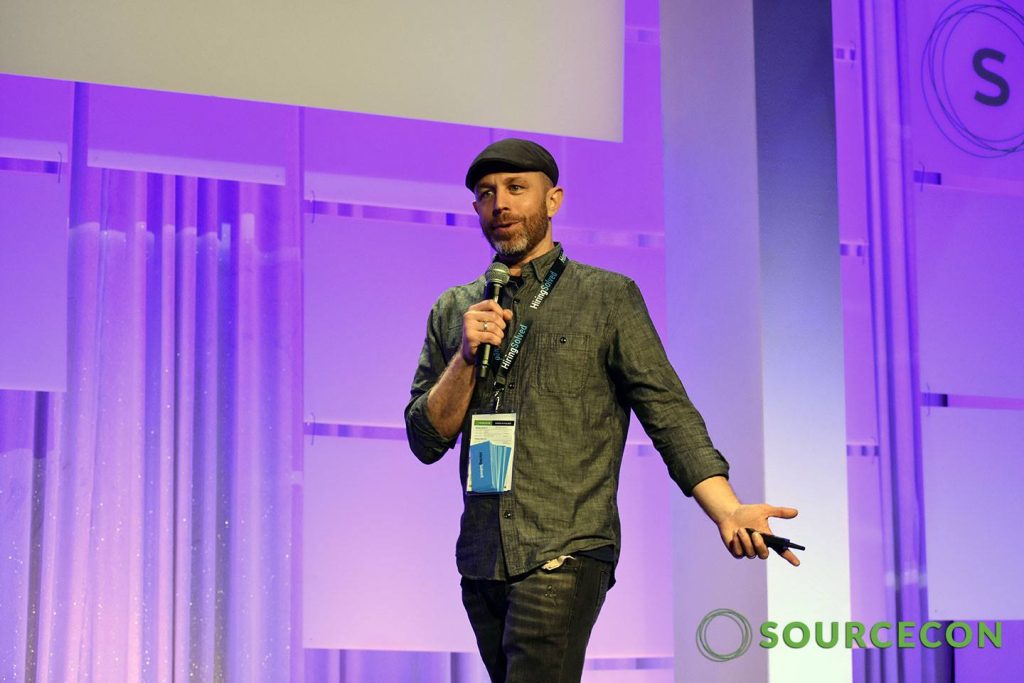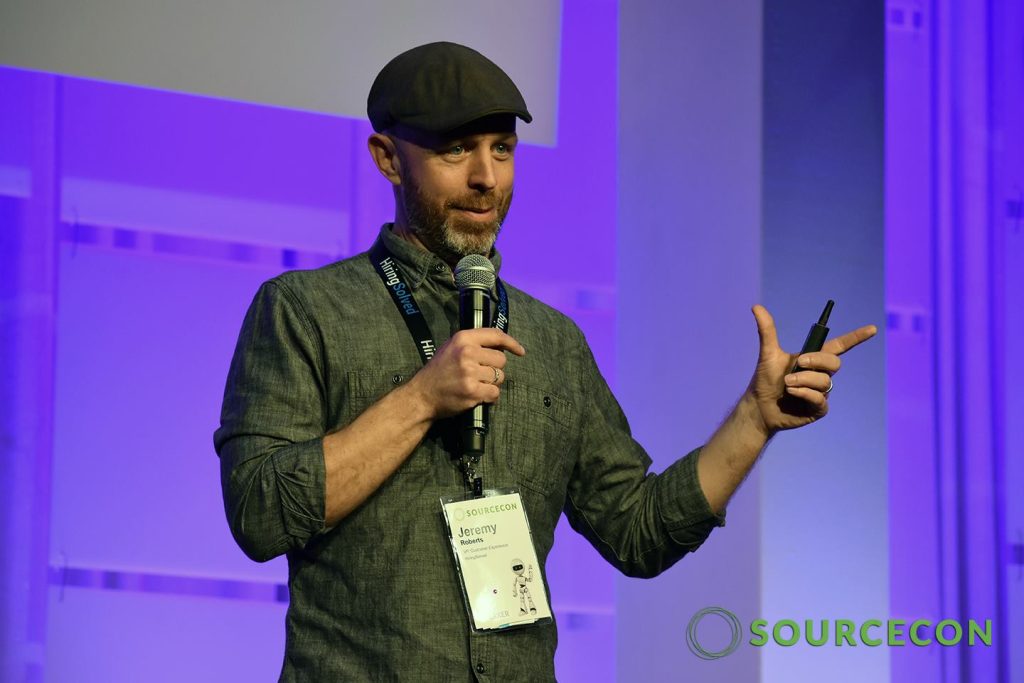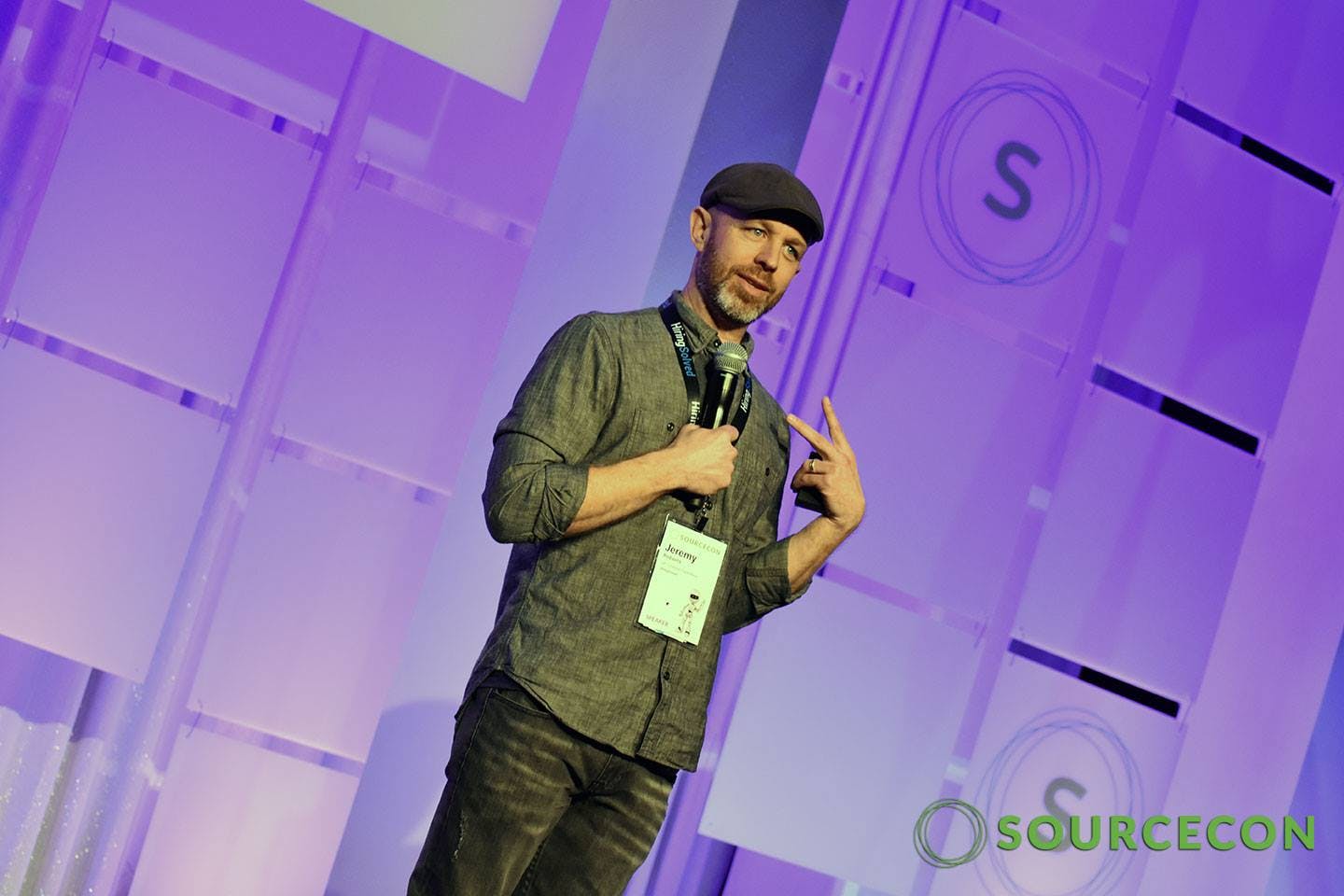When Jeremy Roberts took the stage on the third day of the 2017 Spring SourceCon conference I knew something special was about to happen, he had confidence and focus. I had made sure to get a seat just a few rows back from the front, and taking it all in.
This SourceCon had as a theme “We Control the Robots.” Artificial intelligence/machine learning and similar topics are today at the forefront of a multiplicity of dynamics which will in many respects transform the workplace. While this may be so, there is still much of the human element to the talent acquisition trade that will remain. No one person has a crystal ball to predict how these changes may affect the work we do today and for that matter the long term impact.
Roberts approached this topic with some appropriate advice, focusing in on ROI, the big picture, and what’s nuggets of career wisdom that all talent acquisition professionals can take to heart. Along the way, he shared inspiring stories, tips on how to reinvent oneself, what the modern day sourcer/talent acquisition professional can do to remain relevant not to mention innovative. In sum taking an entrepreneurial approach to every talent acquisition dynamic is a vital need today.
At the front end of his presentation, he shared some of the current headlines in the marketplace today which underscore how machine learning and artificial intelligence are changing the strategies to sourcing and recruiting as a whole; where “robots” or “machines” are transforming our world. Here are a few samples of the articles he pointed to illustrate:
- The End of Sourcing is Near….The Remaining Challenge is Selling. – Dr. John Sullivan
- Professor: Robots Will Take Over Most Jobs, Erode Middle Class. – Brett Downer
- Robots will Take Over Most Jobs Within 30 Years, Experts Warn. – Professor Moshe Vardi

REINVENT YOURSELF:
The challenges that exist today are staying relevant when machine learning and artificial intelligence cause disruption to our workplaces. Routine and repetitive tasks within the talent acquisition landscape are more likely to be automated and outsourced, whereas highly critical and essential functions that the human element can more effectively engage such as the intake meeting, screening candidates, assessing, and closing are more likely to remain as a need. Along with reinvention, he talked about critical factors that are essential to success in life and business. That’s when he talked about something that hit home for me, the Elmore Principles as he called it.
THE ELMORE PRINCIPLES:
The Elmore Principles, important success traits to hone in on any talent acquisition endeavor or career tips to espouse:
- Know Yourself
- Understand Your Strengths And Weaknesses
- Improve Upon Your Weaknesses
- Dominate With Your Strengths
- Find an Environment in Which You Can Thrive
The above are attributed to a high school wrestler, Christian Elmore, who is living his life on purpose. Elmore does not have full use of all his physical capacities, but in spite of his personal challenges he wanted to wrestle, and he found a way to do so. Winning in life, and innovating in your work is similar to what Elmore undertakes. I won’t spoil the closing so read on! As Roberts continued to share pertinent and relevant nuggets of information, he then went on to describe two types of Talent Acquisition Professionals.
TWO TYPES OF TALENT ACQUISITION PROFESSIONALS:
This is a synopsis of the two types of talent acquisition professionals. Firstly, those who embrace only the tools they are given, are not innovative, are an order taker, or think in their box, and never progress forward. The second type of talent acquisition professional is always learning, trying new technologies, wants to “break” the mold, thinks outside of the box, and is innovative. As I listened, I thought about these types of practitioners in every workplace I have been in pondering back to environments where I have seen evidence of these kinds of professionals first hand. The only way to break out of the box is to try new things. One must bring innovation to the table, experiment with new tools, technologies, to be a seller on every call, and focus in on the dynamics of the bigger talent acquisition puzzle.
In further summarizing the trends Roberts had observed; he then delved into changes he had seen from 2008, until now: further defining these two types of talent acquisition professionals with some further illustration, the talkers, and the typers, the traditional recruiter who was partnered with a tech savvy sourcer. Both types of professionals had their weaknesses. The traditional recruiter partnered with a sourcer may be dependent on others to find their candidates, while the sourcer of old may be focused solely on the search and building lists of people. In short, he showed that for every one sourcer and recruiter, evolution had taken place for the business case to build strengths in both areas (talking with candidates vs. finding the candidates and vice versa). Thus, cultivating both areas of strength going forward will be key.
INNOVATION IS STILL KING – BRING BACK YOUR HUMAN FOCUS:
What all must innovate was a slogan that we can all take to heart. Roberts provided some key examples of how to innovate: test limits of tools, find new free tools, suggest improvements to process and sourcing steps, re-design and re-invent and so on. As his presentation finalized, a few key elements emerged, namely where the human element can and should add value. He went on to quote Thomas Friedman:
“No matter your profession – doctor, lawyer, architect, accountant – if you are an American, you better be good at the touchy-feely service stuff, because anything that can be digitized can be outsourced to either the smartest or the cheapest producer.”
In short, we must find a balance between technology and the human aspects of the marketplace, man vs. machine, or the Thiel Principle.
For both hiring managers and candidates, debrief them at each stage and be active in each stage. In short, each element of the human interaction between the hiring manager/candidate and recruiter is essential to maintaining candidate experience, creating best fit, and making the best outcomes come to pass. A machine cannot automate being human. And therein lies the differentiator.

THE CONCLUSION:
At the end of the dialogue, Roberts shared some insights into what he called “your lifelines,” looking to peers in the industry and getting help on common talent acquisition problems, one can find the best outcomes and add value. He shared the story of the connected Atlanta talent acquisition community or a real-life “Ocean’s Eleven” team. When faced with certain issues, many of the infamous Atlanta recruiting community have in the past reached out to each other to come up with dynamic and creative solutions to their local problems. In so doing they found new ways to create greater symbiosis and a win as one approach.
As the last example, he shared the story of Ian Preston who at 17 started a key sourcing tool with experimentation and creativity, Prophet, which now has over 75,000 active users and over 350,000 installs. In short, being innovative he created a tool that many are using today. He was self-taught which should give all of us hope that we can make a difference no matter the endeavor.
To sum up the final focus of this keynote, it is appropriate to go back to Elmore, the wrestler. If one could summarize Robert’s points to an overarching focus one could have this tag line/hashtag as their motto for every aspect of their life’s work: #BeEPIC. I’ll let his video bring the point home which you can view below:
https://www.youtube.com/watch?v=9LBN_DRTLSs&feature=youtu.be
